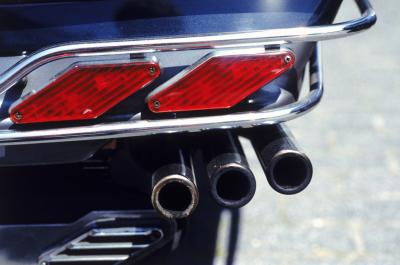
Manufacturers and vehicle owners are forever testing and implementing ways to increase gas mileage. One fuel-saving consideration includes the exhaust system. Vehicles have single, split-type dual or true dual exhaust systems. True dual exhaust systems incorporate separate manifolds, header pipes, catalytic converters and mufflers, creating independent exhaust flow from each engine manifold bank. High-performance dual exhaust can increase gas mileage, but it depends on several variables and an understanding of gas flow dynamics.
Single exhaust is commonly used on smaller 4-cylinder engines that have one exhaust manifold. But it is not uncommon to see it on V-6 and V-8 models where the two manifold header pipes join in a Y configuration and transfer exhaust out of a single exhaust pipe, through a single catalytic converter, muffler, resonator and tailpipe. Even with dual header pipes, when the pipes are joined, it remains a single exhaust system.
True dual exhaust incorporates two exhaust manifolds. Each manifold has exhaust header pipes that join into a solid exhaust pipe on each bank of the vehicle. Each bank has a separate catalytic converter, muffler and in some cases a resonator. Each exhaust bank (right and left) is independent of the other, with no equalizer tube or pipe between. Each exhaust pipe has it own hanger support system and clamps.
True dual exhaust promotes better "breathing" qualities in the exhaust system by allowing burnt combustion gas to exit the exhaust manifold and header pipes faster, creating less back pressure. Some after-market high-performance dual exhaust systems have gradual-bend header pipes for faster and easier flow, free-flow catalytic converters and mufflers and tuned, smooth- bore exhaust pipes. Some high-performance dual exhaust systems create an actual low pressure system, a vacuum that draws residual exhaust gases out of the combustion chamber, thus allowing a more fresh air-fuel mixture to burn hotter and faster.
Excessive back-pressure in the exhaust causes a slight loss in horsepower, which means fewer rpms, because the efficiency of the stroke cycles is decreased. True dual exhaust expels burnt exhaust gases through the system faster, with a slight reduction in horsepower, which is lost when exhaust must be more forcefully pushed through the pipes and components. Rpms can rise during low and medium speed applications but then fall off by approximately 5 psi when maximum, sustained speeds are reached.
Original equipment true dual exhaust, seen on higher-end performance sports cars and trucks, creates better horsepower and fuel gains because it is designed to do so with a particular manufacturer's engine. Gains in aftermarket true dual exhaust depends upon cam type, exhaust manifold type, flow performance statistics of mufflers and catalytic converters, head and valve specifications, timing and exhaust pipe length. If the aftermarket dual exhaust is properly mated to the engine, fuel mileage can increase.
Gains in fuel mileage from true dual exhaust depends significantly on the driving style and habits of the driver. If the driver does not drive consistently by keeping speeds within regular tolerances, there will be little or no gains in fuel mileage. True dual exhaust will raise horsepower, which increases rpms and aids in better gas mileage, when the accelerator pedal is used in normal fashion.